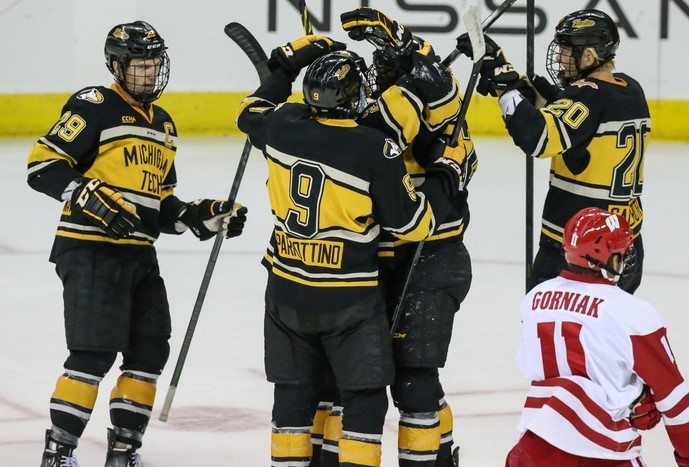
Each week during the season, we look at the big events and big games around Division I men’s college hockey in Tuesday Morning Quarterback.
Paula: It’s October and we’re talking college hockey, which means that something is going right in the world. It is good to be back.
We’re mixing it up a bit for this season’s TMQ, with Dan Rubin and Ed Trefzger joining Jimmy Connelly and me in the regular rotation to provide a bigger mix of perspectives about the sport we love. The four of us will also be tackling stories of national interest throughout the season.
This week, Ed Trefzger is here with me to talk about the opening weekend. Welcome, Ed — and look at how much we already have to discuss. There are several things that emerged from the weekend that I’d like to dive into. For me, one of the biggest storylines is B1G Hockey’s performance.
First, there was Atlantic Hockey’s success against the Big Ten Friday night and B1G Hockey’s 2-4 overall performance to start the year — hardly inspiring for B1G fans.
Then there was the conference’s decisive rebound Saturday with the exception of Wisconsin, which got swept by Michigan Tech. The three teams that lost to AHA Friday night — Michigan State, Ohio State, Penn State — outscored their opponents 17-4 in three Saturday wins.
Both Minnesota and Michigan swept opponents, with the Wolverines scoring four unanswered goals late in the game Saturday to come back against Lake State. It’s dizzying.
Then there’s the start of a new league that’s really an old friend, the CCHA. That conference went 4-7-1 in non-league play with that MTU sweep and competitive play in many losses.
Out where I am, the hockey looks pretty interesting.
Even though it is far too soon to extrapolate from this, what do you think, Ed, about what the first weekend of play may have told us about the upcoming season? What jumps out to you?
Ed: First, Paula, I’m glad to be part of the rotation here on TMQ this season. Thanks for having me!
Add to that mix three ranked teams participating in last weekend’s Ice Breaker in Worcester – Boston College, Quinnipiac, and Northeastern – and we’ve already had a bunch of early-season games that will have postseason significance when it comes to selecting at-large teams for the NCAA tournament. We’ll get into all of the games you mentioned.
But where I’d like to start is with the team that has the toughest schedule out of the gate: Minnesota State. The No. 1 Mavericks split at home with the team that ousted them from the Frozen Four last season, No. 2 St. Cloud, after sweeping then-No. 1 UMass on the road last weekend.
The two contests were what we were expecting in the 5-4 national semifinal between those two teams in April, with strong performances in net by Dryden McKay and David Hrenak. McKay tied Ryan Miller’s career record of 26 shutouts with the win on Friday, and the Minnesota State senior still has as many as 32 more regular-season games to go.
If that wasn’t enough, Mike Hastings’ squad takes on Providence in the Ice Breaker hosted by Minnesota Duluth on Friday, and then faces either the Bulldogs or Michigan on Saturday. That’s six ranked teams in a row to start the season.
I’d like to hear your take on Michigan Tech. How good is Joe Shawhan’s team, and should Tony Granato and Wisconsin be concerned about getting swept last weekend?
Paula: Looking at that series between Michigan Tech and Wisconsin last weekend, it may have seemed as though Wisconsin would be heavily favored, but a closer look at each team shows that they are pretty evenly matched – at least at this point in the season.
To answer your questions, Ed, I think that Shawhan is building a good team and that Granato is rebuilding a good team.
Even though the Huskies finished sixth in the WCHA last season, they ended up on the cusp of tournament contention in the PairWise Rankings, and Michigan Tech returns almost all of its team this season. That puts the Huskies in a good position to climb up the CCHA standings this year.
Wisconsin finished first in the Big Ten last year but, wow, did the Badgers lose a lot as soon as the season ended. In addition to losing Hobey Baker winner Cole Caufield, the Badgers parted ways with their three next top goal scorers. That is tough for any team to overcome, especially at the start of a season. Additionally, the Badgers seem to need a little time at the start of each season to solidify.
Do I think that Joe Shawhan has reason to be optimistic? Absolutely. And a sweep like this can really fuel a rebuilding team’s self-confidence. Do I think that Tony Granato has reason to be alarmed? Not necessarily. The Badgers return some veteran talent this season, and a lot depends on how they respond this weekend when they welcome Army West Point.
You mention Minnesota State’s blistering schedule and that terrific field in the IceBreaker, and all of that has me thinking back to the anomalous start to 2020-21, when we weren’t even certain that we’d be talking about college hockey for a full season. It was strange to focus so much on uncertainty last season and the weight of every single game, and yet that’s what college hockey had become even before that, a sport in which games played in October could have massive ramifications the following March.
I do think that if Wisconsin gets hot, they may look back at this weekend against MTU with regret.
Ed: I think you’re right about that, Paula. A single game can have three-decimal points significance come March. And while they do say that every game counts whether it’s played in October or March (and it does), coaches also are looking for different things early in the season while they’re still trying to figure a few things out and can’t approach the game identically to one played down the stretch.
While Wisconsin was swept in non-league play, three Big Ten teams battled back on Saturday to earn splits. Fans of other leagues are probably tired of hearing the mantra about Atlantic Hockey getting better every year (and I think the more established leagues like AHA’s little brother status, though they might not admit it) but the strong showings by Canisius, Bentley, and a very young Air Force were celebrated around the conference.
Penn State, Ohio State, and Michigan State did take care of business on Saturday to salvage their weekends, leaving Atlantic Hockey at 3-16 out of conference, with still a lot of games left on the schedule to close the gap. Commissioner Bob DeGregorio wants to see an at-large bid for his league, but as he told me last spring, you not only have to schedule those opponents, you have to beat them. They’ll need to be above .400 in overall non-conference winning percentage to have a shot at that.
Michigan and Minnesota held serve as you noted, but that Michigan comeback shows just how dangerous the Wolverines are. There’s no question that a team with seven first-rounders – and some other high picks – is hugely talented. The challenge for Mel Pearson and his team will be to perform consistently at their lofty potential.
Now, I know there’s a USCHO reader drinking game that requires people to do a shot when Paula mentions the CCHA (does that count for the new CCHA?), but we do need to talk about that conference a bit. Last week on USCHO’s Game of the Week podcast, Mike Hastings told us that the atmosphere around the new league was “refreshing,” and he pointed to Don Lucia’s experience as a head coach as very important to giving the conference a great beginning.
I’m very interested in seeing how the season goes for the new CCHA. A more compact footprint helps travel, and a more competitive group top-to-bottom should make for an entertaining battle for the top of the standings come February.
Paula: I was completely unaware of this USCHO reader drinking game that requires consumption of alcohol when I mention the CCHA. You’d think that because of this, I’d have a higher Twitter following.
Hmm … the CCHA you say?
(I hope that people aren’t reading this at work.)
As for the league you mention – see what I did there? all good things in moderation – there is a great buzz around the refurbished CCHA. In talking with Don Lucia for another article at the start of the season, he was very happy with the branding of that league. Dominic Hennig, who has roots in Ferris State from the previous incarnation of the conference, has done a really fine job with the way that the league itself is packaged. Fans were appreciative of the highlight tweets put out by the league this past weekend, I’m sure that they’ll continue to be pleased with how everything is marketed.
While marketing isn’t games played, it’s clear that the CCHA is committed to elevating its profile in addition to becoming a very competitive conference. The compact footprint you mention is important, without question, as is the nature of the programs in the conference. For all of the CCHA schools, D-1 men’s hockey is a big deal on campus, and for a few of the programs, hockey is king. I’ve always thought that current conference is exactly what should have happened when the old CCHA folded. I think everyone involved is going to be happier with this alignment.
That does leave several teams out in the cold, though. St. Thomas was an easy fit into the new CCHA for its first D-1 season this year, but Arizona State is still looking for a conference after playing against Big Ten teams last year, newcomer Long Island University is an independent and Alaska has been left out in the cold completely with the demise of the WCHA.
We’ve probably lost Alabama-Huntsville for good and while Alaska Anchorage plans to return to D-1 play with the 2022-23 season, I see that as unlikely. The potential permanent loss of Robert Morris is a different story, with that team’s 18-year history and every bit of it played while aligned with either College Hockey America or the AHA – so shortsighted on the part of that institution’s leadership, but I digress. Even with the impending addition of Augustana University in Sioux Falls, S.D., college hockey has yet to figure out how to stabilize itself completely. The newly resurrected CCHA, at least, gives its member teams some security.
Ed: I would be least concerned about Arizona State. The Big Ten would be a great place for the Sun Devils to land, especially with their new 5,000-seat arena opening next season.
Yet even if ASU stays independent for a while, coach Greg Powers has mastered the art of schedule making with the right level of competition. If his team wins 20 games, they’re almost assured an NCAA postseason. But a spot in the Big Ten now or Pac-12 hockey down the road would be better.
I am concerned about other schools finding homes, though. Augustana and Lindenwood are somewhat separated from other programs, and that’s been the issue for the Alaska schools and Huntsville.
Finding homes for new programs should be a shared task among the six conferences, and the need to add a seventh or eighth should be part of that discussion. (This isn’t a new problem either. I remember having virtually this same discussion in the hotel lobby with a coach at the Frozen Four in 2007.)
Remember the “little brother” comment above? Atlantic Hockey shouldn’t be expected to take teams automatically and shouldn’t be vilified for not adding a team.
While we’re on the topic of cooperation, I’m hearing that the six conferences are very unhappy with the lack of a replacement for College Hockey Stats, and coming up with a successor is now an urgent priority for conference commissioners.
For more than two decades, collegehockeystats.net was the central location for all official men’s and women’s hockey box scores and statistics, and site owner Tim Danehy has been instrumental in helping the NCAA with Pairwise calculations at tournament time. The implementation of new statistics software by the NCAA has left a giant, gaping hole where College Hockey Stats used to be.
Coaches, journalists, broadcasters, sports information directors, and fans have all lamented the loss of this resource. It may not have had the most current technology, or have been the prettiest site on the internet, but College Hockey Stats was fast, comprehensive, and reliable.
It’s really inexcusable that no replacement was put in place, and it’s a problem that needs to be solved immediately.


